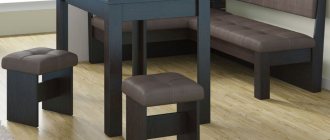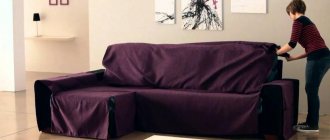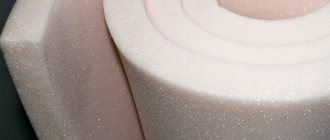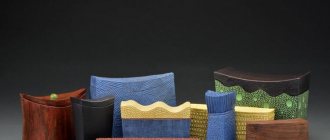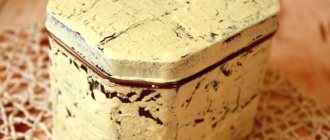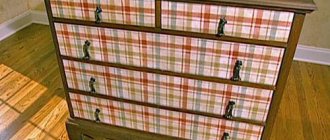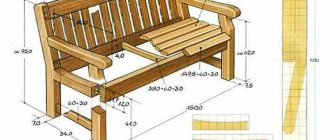Benefits of DIY
Making covers for stools with your own hands is a fascinating creative activity that has a number of advantages. Homemade capes are practical, fully match the size of the furniture, protect against dirt and many negative external factors: steam, sunlight, moisture. The models will exactly match the overall style of the room.
Making your own cover allows you to realize design ideas and update boring furnishings. Creating a cape is not a very difficult task; you just need to stock up on the necessary materials and tools, which will cost much less than reupholstering or purchasing a new product.
At home, you can make one-piece covers for stools that will perfectly disguise furniture flaws. Products in the form of a soft, comfortable pillow and removable ones with ties are popular. They are sewn based on individual patterns, since there are no universal options.
Exact match to stool dimensions
A homemade case will organically fit into the interior design
Opportunity to realize creative potential
How to make stool covers with your own hands
You can make a furniture cape from the following materials:
- gabardine. A soft fiber that has good strength. This fabric has a slight shine and is water-repellent. However, it has a significant drawback - during use the material slips a lot;
- crepe-satin. Soft and silky fiber with good wear resistance. The material practically does not wrinkle or stretch. Satin crepe looks elegant and is suitable for decorating stools in the living room;
- lycra. Dense synthetic fiber, characterized by wear resistance. Lycra is a budget-friendly and durable material;
- spandex. Polyurethane fiber, which is most often used for upholstering kitchen stools. The material does not absorb moisture or odors and can be easily cleaned with plain water.
Filling for covers
Furniture covers are also made from linen, brocade, and faux fur. It is recommended to make products from durable and moisture-resistant materials that respond well to high indoor humidity and periodic temperature changes.
Important! The best option is leather or spandex.
You might be interested in: Making patterns and sewing hoods for raincoats and raincoats
Required Tools
To make a cover for a stool with your own hands, you need to prepare:
- a piece of soap or chalk for marking fabric;
- ruler for measurements;
- pencil;
- pins.
The seams of the cover must be sewn with a sewing machine. It is convenient to make the pattern on cardboard or plastic. You will need a piece whose dimensions are slightly larger than the future seat. To calculate the required amount of fabric, you need to add another 10 cm to the measured area. The elastic is selected with a width of at least 2-3 cm. The threads must be strong and match the color of the selected material.
Sewing a soft pillow is not complete without filling. Most often, padding polyester with a density of 200 g/m² and a thickness of 3-4 cm is used. Cotton bias tape is useful for work; for 4 products you will need approximately 10.5 m. It is used for edging covers, processing cuts, sold in craft stores or made on one's own. To make the lining, it is better to choose soft textiles that will exactly repeat the shape of the kitchen stool.
Crochet
A stool seat can even be knitted from leftover yarn. The needlework algorithm, which is described below, allows you to create a soft stool with a minimum of cost.
Cushions for square furniture can be created with a checkerboard pattern, and for round products - with a pattern in the form of flowers.
Round form
It is best to make a round seat with an ornament - small flowers with 6 petals. Necessary tools and materials for crocheting - diagram, 4.5 mm hook, a lot of black yarn, multi-colored yarn for flowers.
Flowers are knitted separately, from the center to the edges; the petals are knitted one at a time, starting with stitches from the center, then additionally tied. Black yarn is used as a background. It needs to be knitted until it forms a round shape slightly larger than the seat. An elastic band is threaded through the bottom and the cover is pulled over the stool.
The knitting pattern for a round seat will take up to 4 hours of work.
Square shape
The square shape is created in 2 hours. You will need:
- skeins of multi-colored yarn;
- more yarn of the same color for tying;
- hook 4.5 mm.
We knit from multi-colored strips of different colors: one strip is yellow, the other is blue, etc. They should be knitted with a double crochet. A stool requires 22 strips.
When the stripes are knitted, along the smaller edge they need to be knitted in one line (in two groups - 11 strips together, then 11 more), all the loops are a connecting post. Then the resulting two groups should be intertwined with each other so that a pattern of squares arranged in a checkerboard pattern is obtained. The last steps are to tie the entire structure around the perimeter, creating a large strip along the edge instead of an edging. It is better to do all binding work with gray, white or black yarn.
How to make a basic pattern
To create a pattern for a square stool cover, you need to measure the parameters of its upper part. Standard dimensions are 30 x 30 cm. You can draw a diagram on a piece of cardboard, then attach it to the filler, trace it with chalk and cut out the element exactly according to the markings made.
The same must be done with the main fabric. An additional 1 cm is added on each side and another 6 cm for the thickness of the product, that is, the height of the filler. To hem the bottom, add 3 cm. After this, the part is cut out along the contour.
It’s easier to attach a round or fanciful seat to a sheet of paper and trace it.
For example: the length of the side of the chair is 30 cm, the thickness of the filling is 5 cm. To cut the base, you need to add a seam allowance of 1-1.5 cm to each side. The strip for stitching to the base will have a length of 30 x 4 + 1 – 1.5 cm. The result will be 121/121.5 cm. To calculate the width, take a foam thickness of 5 cm and add a hem to the drawstring of 4-5 cm. The result is 9-10 cm.
Freeform technique
Freeform is a type of knitting in which multi-level elements with volume are sewn onto a uniform base: flowers, petals, ruffles.
It’s easy to make chair seats with your own hands using the freeform technique. You just need to knit the patterned elements and then connect them with a plain strapping. When creating volumetric elements, you can use your imagination rather than follow diagrams. Patterned elements can also be made by hand; crochet them.
Please note that a large amount of jewelry will make sitting uncomfortable. Therefore, all elements must be “sinked” when tying so that they are on the same level, or placed on the sides of the stool.
Pillows sewn or knitted by yourself have many advantages. Their design is the way the owners would like it to be. Hand-made stool decorations give the apartment more coziness than store-bought ones. It is especially convenient to make a pillow with your own hands when the stool seat is of non-standard sizes.
Decorating the product
A homemade cover for stools should be attractive in appearance. If a tapestry is used to decorate the cover, a fabric decorated with floral patterns with a large flower in the central part will be an excellent decoration. Thanks to muted colors, the combination of shades does not look pretentious, but stylish.
Combinations of different materials and textures look interesting. Round or square covers are complemented with braid, flounces, and lace inserts. Satin stitch embroidery is popular; in most cases, floral patterns are used around the perimeter of the product, flowers in the central part, and abstract patterns.
To create embroidery, we use threads with sufficient strength and long-lasting color, which will not fade with intensive use and frequent washing.
You can decorate the stool cover using decorative zippers, buttons, and snaps. The use of decor is limited only by the imagination of the master. The legs of the chair can be painted to match the capes or varnished, preferably in two layers. It is better to apply the compounds before sewing the seats to allow the surface to dry.
Homemade covers for kitchen stools help to update and decorate furniture and make the operation process more convenient. Stylish throws or soft pillows with ties will add freshness and novelty to the interior. Not only experienced seamstresses, but also beginners can handle the work; you just need to follow the master classes and recommendations on the choice of materials and tools.
Mounting options
You can attach a cushion to a chair with your own hands in different ways. The most popular option is lace-style ties. But there are other methods.
| Type of fastening | Peculiarities | How to do it |
| Ties (ropes) | The ties must be made from the same fabric as the product itself; in some cases (if the seat is plain), it is possible to choose a contrasting option | A pair of thin ropes are attached to the corners. They are tied in a knot under the seat of the stool |
| Velcro | Over time, they become dirty and cease to perform their function, so they require periodic cleaning. | Four Velcro strips are sewn to the edges by hand or machine |
| Elastic bands at the corners | The fastening should not be too tight | A drawstring with an elastic band is sewn to the seat, then the product is put on the chair and aligned around the perimeter |
Rules for selecting chair height for adults and children, standards
Any fastening is sewn only after the seat itself is sewn. After this, the product must be tried on and aligned. The cover should not cover the seat. An option that is too spacious is also bad, it will slide.
You can use colored ribbons made of any synthetic material as ties. Before working, you need to singe the ends so that the fabric does not fray.
Ties
Velcro
Rubber bands


